 Inverse Trigonometric Function: Arccosine (Part 2)
Inverse Trigonometric Function: Arccosine (Part 2)
(This page is Part 2. Click here for Part 1.)
Formal Name Versus Function Notation Abbreviations
The formal name of the function being discussed in this section is ‘arccosine’. It is pronounced arc-CO-sine (with a long ‘i’ in ‘sine’).
When using function notation, ‘arccosine’ is abbreviated as ‘$\,\arccos\,$’. It is pronounced the same as ‘arccosine’. Thus, ‘$\,\arccos x\,$’ is read aloud as ‘arccosine of $\,x\,$’.
An alternative notation for the arccosine function is ‘$\,\cos^{-1}\,$’. This alternative notation is modeled on the standard notation for inverse functions: if $\,f\,$ is one-to-one, then its inverse is called $\,f^{-1}\,.$
The function notation ‘$\,\cos^{-1} x\,$’ can be read aloud as ‘arccosine of $\,x\,$’ or ‘the inverse cosine of $\,x\,$’. Don't read ‘$\,\cos^{-1} x\,$’ as ‘cosine to the negative one of $\,x\,$’! There is no reciprocal operation going on here—it's just standard notation for an inverse function.
Convention for Multi-Letter Function Names
Since both ‘$\,\arccos\,$’ and ‘$\,\cos^{-1}\,$’ are multi-letter function names, the standard convention applies: the parentheses that typically hold the input can be removed, if there is no possible confusion about order of operations.
Thus, you usually see ‘$\,\arccos x\,$’ and ‘$\,\cos^{-1} x\,$’ (no parentheses), instead of the more cumbersome ‘$\,\arccos (x)\,$’ and ‘$\,\cos^{-1} (x)\,$’ (with parentheses) .
Function Name Versus Output From the Function
The function name is ‘$\,\arccos\,$’. The number ‘$\,\arccos x\,$’ is the output from the function ‘$\,\arccos\,$’ when the input is $\,x\,.$
Similarly, the function name is ‘$\,\cos^{-1}\,$’. The number ‘$\,\cos^{-1} x\,$’ is the output from the function ‘$\,\cos^{-1}\,$’ when the input is $\,x\,.$
Preferred Notation
Since the cosine function does not have a true inverse, this author believes the notation ‘$\,\cos^{-1}\,$’ is misleading and lends itself to errors. This author strongly prefers the notation ‘$\,\arccos\,$’.
Alternate Definition, Using Degrees Instead of Radians
Inputs to trigonometric functions can be viewed as real numbers (radian measure) or degrees.
For example, $\,\cos \pi = -1\,$: here, $\,\pi\,$ is radian measure.
Equivalently, $\,\cos 180^\circ = -1\,$: here, $\,180^\circ\,$ is degree measure.
Here's what the definition of arccosine looks like, using degree measure instead of radian measure:
$$ \begin{gather} \cssId{s31}{y = \arccos x}\cr\cr \cssId{s32}{\text{if and only if}}\cr\cr \cssId{s33}{\bigl(\ \cos y = x\ \ \text{and}\ \ 0^\circ \le y\le 180^\circ\ \bigr)} \end{gather} $$Calculator Skills
If a calculator is in degree mode, then $\,\arccos x\,$ is reported in degrees. If a calculator is in radian mode, then $\,\arccos x\,$ is reported in radians.
Graph of the Arccosine Function
For a one-to-one function $\,f\,,$ the graph of its inverse, $\,f^{-1}\,,$ is found by reflecting the graph of $\,f\,$ about the line $\,y = x\,.$ Below, this technique is used to construct the graph of the arccosine function:
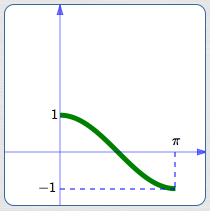
Domain: $\,[0,\pi]$
Range: $\,[-1,1]$
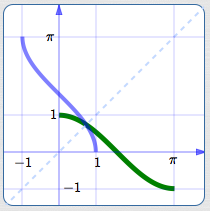
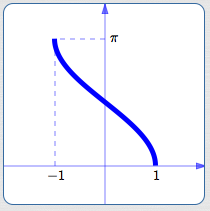
Domain: $\,[-1,1]$
Range: $\,[0,\pi]$
Notice that the domain and range of a function and its inverse are switched! The domain of one is the range of the other. The range of one is the domain of the other.
Relationship Between the Cosine and Arccosine Functions
For a one-to-one function $\,f\,$ and its inverse $\,f^{-1}\,,$ there is a simple ‘undoing’ relationship between the two:
- $f^{-1}\bigl(f(x)\bigr) = x\,$ for all $\,x\,$ in the domain of $\,f\,$: the function $\,f\,$ does something, and $\,f^{-1}\,$ undoes it
- $f\bigl(f^{-1}(x)\bigr) = x\,$ for all $\,x\,$ in the range of $\,f\,$: the function $\,f^{-1}\,$ does something, and $\,f\,$ undoes it
Since the cosine and arccosine functions are not true inverses of each other, the relationship between them is a bit more complicated.
The Direction Where Cosine and Arccosine ‘Undo’ Each Other Nicely
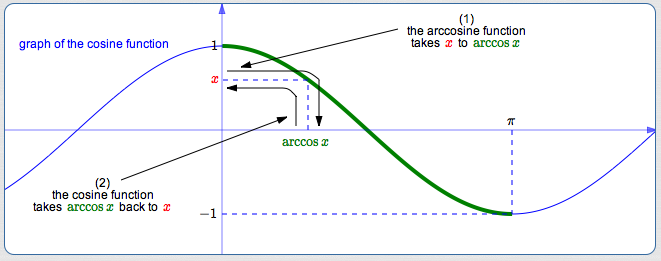
Here's the direction where they do ‘undo’ each other nicely: start with a number, first apply the arccosine function, then apply the cosine function, and end up right where you started.
Here are the details: For all $\,x\in [-1,1]\,,$
$$ \cssId{s66}{\cos(\arccos x) = x} $$- Start with $\,\color{red}{x}\in [-1,1]$
- The arccosine function takes $\,\color{red}{x}\,$ to $\,\color{green}{\arccos x}\,$ in the interval $\,[0,\pi]$
- The cosine function takes $\,\color{green}{\arccos x}\,$ back to $\,\color{red}{x}$
The Direction Where Cosine and Arccosine Don't Necessarily ‘Undo’ Each Other Nicely
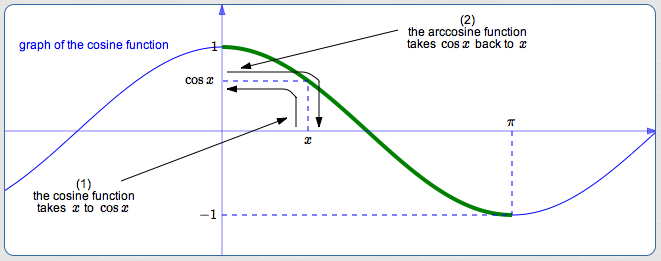
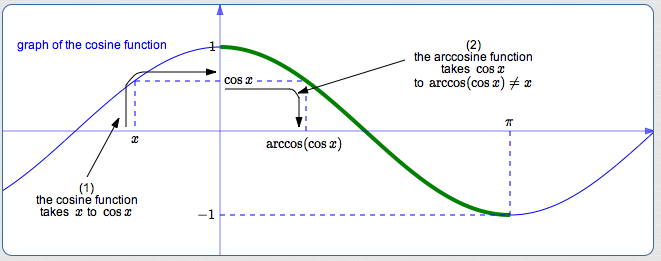
Here's the direction where they don't necessarily ‘undo’ each other nicely. Start with a number, first apply the cosine function, then apply the arccosine function. If the number you started with is outside the interval $\,[0,\pi]\,,$ then you don't end up where you started!
Here are the details:
For all $\,x\in [0,\pi]\,,$
$$ \cssId{s76}{\arccos(\cos x) = x} $$(See the top graph above.)
For all $\,x\not\in [0,\pi]\,,$
$$ \cssId{s79}{\arccos(\cos x) \ne x} $$(See the bottom graph above.)
Example: Find the Exact Value of $\,\arccos(-0.5)\,$
Use both the unit circle and a special triangle.
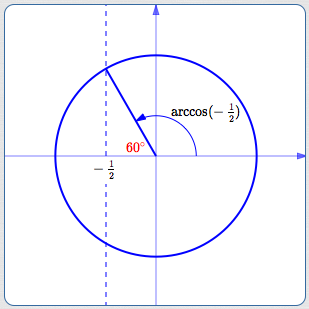
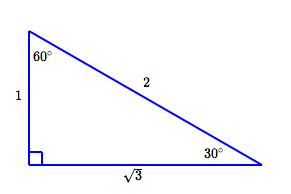
Using the degree definition: $\,\arccos (-\frac 12)\,$ is the angle between $\,0^\circ\,$ and $\,180^\circ\,$ whose cosine is $\,-\frac 12\,.$
Recall: Cosine is the $x$-value of points on the unit circle.
Draw a unit circle. Mark $\,-\frac 12\,$ on the $x$-axis. Mark the unique angle between $\,0^\circ\,$ and $\,180^\circ\,$ that has this cosine value. This (positive) angle is $\,\arccos(-\frac 12)\,.$
Does any special triangle tell us an acute angle whose cosine is $\,\frac12\,$? Yes! The cosine of $\,60^\circ\,$ is $\,\frac 12\,.$ Thus, the reference angle is $\,\color{red}{60^\circ}\,,$ as shown.
Thus, $\,\arccos(-\frac 12) = 180^\circ - 60^\circ = 120^\circ\,.$
Using radian measure: $\displaystyle\,\cssId{s98}{\arccos(-\frac 12) = \frac{2\pi}3}\,.$